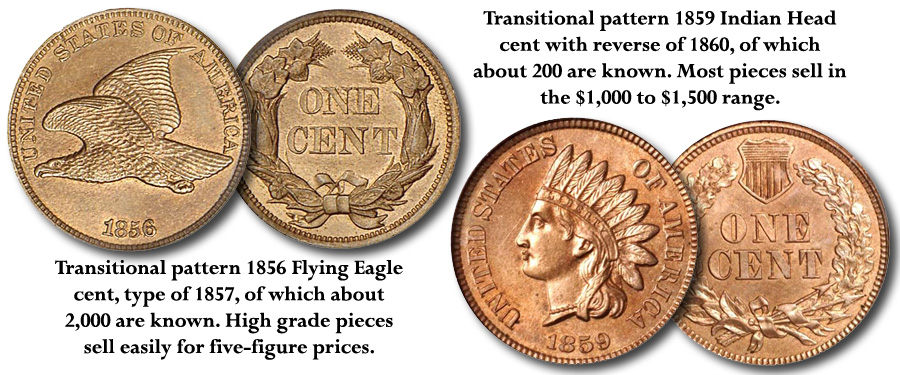
In 1859 an estimated 1,000 or more specimens were made of a so-called transitional pattern (Pollock-272, Judd-228) utilizing the standard 1859 Indian Head cent obverse in combination with the oak wreath and shield reverse (as regularly adopted in 1860). Unlike most patterns, nearly all strikings were made in circulated strike format instead of Proof. Which raises the question: Is it a pattern or is it a regular issue?
Over the years some authors and editors have incorporated these into the regular series, most notably in the listing in the 18th (and last) Edition of the Standard Catalogue of U.S. Coins, published in 1957. This insertion was at the behest of editor John J. Ford, Jr., successor to Wayte Raymond. Richard Snow suggests that many of these pieces may have been stored at the Mint and in the late 1870s distributed to collectors, about the same time that leftover Proof 1862 cents were released (letter to the author, April 10, 1996).
I became attracted to this variety, then known as AW-312, in the early 1950s when I first discovered the fascinating subject of patterns. I sought them out and bought any that I could find. They were not particularly common then or now, although I do recall buying one for $5 described as a regular 1859. The dealer apparently did not look at the reverse! It was back in the early 1950s when John J. Ford and I discussed this coin, by which time I already considered it to be a cherry-picking delight. He was firmly convinced it was one of the greatest unappreciated rarities of the age. He had been buying them quietly, starting in the 1940s, and by that time had gathered 17 examples. It does not strain credulity to state, as indeed John J. Ford, Jr. believed, that these were regular circulation strikes, made in the course of normal business.
There is a peculiar situation in American numismatics, and it is this: If it is listed in the Guide Book of United States Coins, anybody and everybody seeks to acquire it. If it is not listed, then the demand is somewhat limited, usually to those who have a copy of Dr. J. Hewitt Judd’s United States Patterns or who are otherwise students in the series.
The 1856 Flying Eagle cent, a transitional pattern with the same obverse and reverse used regularly in 1857, of which at least several thousand pieces were struck, is listed in the Guide Book, and brings tens of thousands of dollars if in choice grade. On the other hand, the 1859 Indian cent with reverse of 1860, far, far rarer, with probably no more than a couple hundred known, languishes. In the interest of full disclosure (not that this is necessary in numismatics), I still have a nice example, which I appreciate.
However, I have nice examples of other things, and try to write on an objective basis. Hyperbole and such things are simply not my style. The point of this column is that if you are looking for something special, the ‘pattern’ coin, which might not really be a pattern at all, is quite inexpensive, comes on the market with some regularity, and is apt to cost perhaps $1,500, a tiny fraction of the much more plentiful 1856 Flying Eagle cent. It would seem to me that there is room in any Indian cent collection for an example of this very curious coin.





